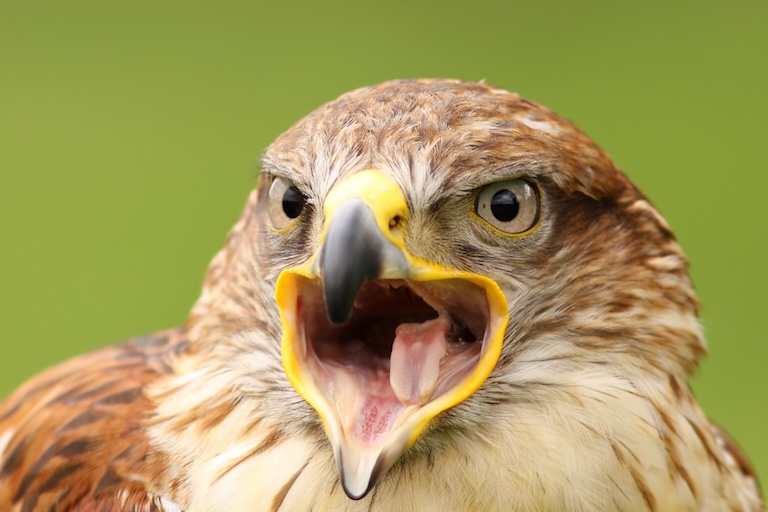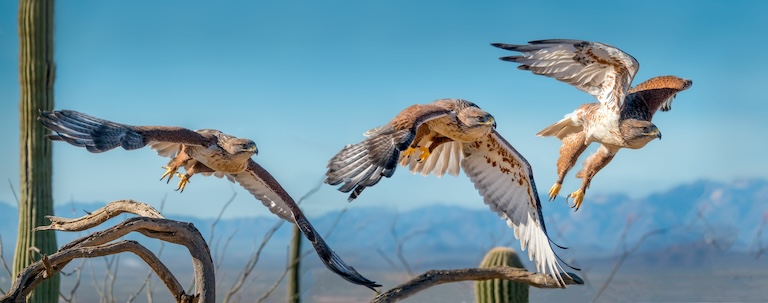Ferruginous Hawk Profile
Like the Hiphopopotamus and Scroobius Pip, the Ferruginous Hawk is much more than just a really cool rapper name.
This big, scruffy raptor’s Latin name translates to “Royal buzzard”, and this is more accurate, as it’s not actually a hawk at all, but one of the largest and fastest of the Buteo genus; a group of stout-winged buzzards.
Falconers consider it a large and powerful bird, not suitable for beginners due to its weight, stubbornness and tough attitude.

Ferruginous Hawk Facts Overview
| Habitat: | Dry grasslands |
| Location: | North America |
| Lifespan: | 20 years in the wild |
| Size: | Up to 71cm (28 in) tall, with a 1.5m (5ft) wingspan |
| Weight: | Up to 2.3 kg (80.0 oz) |
| Colour: | Browns and greys on the wing, speckled white breast |
| Diet: | Mostly rodents, other small mammals, birds |
| Predators: | Few, sometimes Golden eagles |
| Top Speed: | Average 90 km/h (56 mph), faster in a dive |
| No. of Species: | 1 |
| Conservation Status: | Least Concern (IUCN) |
Ferruginous hawks are some of the largest raptors in North America, and they’re plains specialists, occupying dry grasslands, often as the apex predator in their area.
They will sometimes compete with golden eagles, but on the whole, they have their first pick of prairie dogs and other rodents in the grasslands of North America.
Their name is misleading, as they’re actually a species of buzzard, but they’re popular among experienced falconers as robust and powerful hunters.
This is a species on the rise, and their numbers have increased steadily to the point where they are not a conservation concern at this time.
Interesting Ferruginous Hawk Facts
1. They’re not Hawks
Only in the US are Buteos called hawks, but they’re not taxonomically true hawks. While both are in the Acipitridae family of raptors, they diverge at the subfamily level, with true hawks comprising the subfamily Accipitrinae, and including such icons as the goshawks and sparrowhawks.
Ferruginous hawks are members of the Buteoninae subfamily, and the Buteo genus: a group of brad-winged raptors containing the common buzzard and the Red kites.
Within this subfamily, the genus Buteo contains all the true buzzards, though many are often referred to as hawks colloquially.
Buteos are generally bigger than hawks, and the Ferruginous hawk is one of the largest. These are animals built to soar and fly with a sort of laboured reluctance. But make no mistake, these are fast and powerful birds when they want to be!
2. Big Buteos
The ferruginous hawk is the largest species of “hawk” in North America. They can weigh over 2kg, and migrate at an average speed of around 90 km/h. It’s said they can dive at incredible speeds, but the actual figure is hard to verify.
The Red Hawk is possibly one of its closest relatives and a fair basis for comparison. Relative to this bird, the Ferruginous hawk has much smaller, stockier feet with enormous muscles in the legs. They’re heavier and dense, too, with smaller wings.
This gives them more momentum on windy days and they’re said to generate huge power from their strong breast muscles for pulling them through rough weather.
Compared with the red hawk the Ferruginous hawk also has a much wider beak. Some falconers nickname them frog hawks because of this, and it lets them swallow much larger gulps, sometimes finishing a rodent off in one piece.
These large, robust beaks also allow the bird to kill with its beak when the talons aren’t enough, something which other buzzards typically do less. 1

3. They’re tough
Buteo birds are tough in general, and mostly opportunistic hunters. All over the world, there are rodent species that are preyed upon by this genus, but the the Ferruginous hawk is one of the largest in town and can bring down prey much bigger than most.
Prairie dogs are one of the popular foods for this species, but jackrabbits, cottontails and snakes are commonly eaten too. They’ll also take birds on the wing occasionally, and even bats, marmots and weasels. In falconry, some people use them to hunt geese and other water birds.
4. They can hunt from the ground
Hunting prairie dogs involves waiting outside burrows for their dinner to emerge. They may seek out and watch for prey from a perch, but this species is quite competent on the ground, too.
Some hunts occur entirely from the ground, and this might be a way of avoiding being spotted by their targets, who are looking for death from above.
Hunting success was established by researchers to be higher when on the ground than in the air. 2
5. They can kill with their beaks
Many large raptors like this kill with a piercing blow to the back of the target animal. Despite having small talons, the Ferruginous hawk is more than capable of killing this way, but will also involve its beak more than other similar species. 3
6. Their mating rituals are spectacular
Like red hawks, these birds engage in incredible aerobatic displays when courting.
To begin with, they will sour with elevated wings, then the male will dart at the female. Upon reaching her, the two will grapple, their talons engaged, and they will cartwheel through the air. They may do this several times, but a mated pair will then bond for life. 4
7. They’re hard to film
Ferruginous hawks are said to be extremely nervous and skittish when close to people. They’re hard to film directly, so researchers have to put up remote and automatic cameras to monitor their nesting behaviour. 5

8. They’re on the rise
Thankfully, this is a species that appears to be doing quite well. The usual threats of habitat degradation and destruction are present for the Ferruginous hawk, but over the last 40 years, the species has undergone a significant increase in number.
This increase has averaged 26% per year, and they are now considered a Least Concern species by the IUCN. 6
Ferruginous Hawk Fact-File Summary
Scientific Classification
| Kingdom: | Animalia |
| Phylum: | Chordata |
| Class: | Aves |
| Order: | Accipitriformes |
| Family: | Accipitridae |
| Genus: | Buteo |
| Species: | Regalis |
Fact Sources & References
- Ben Woodruff (2022), “Falconry: Ferruginous Hawks introduction”, YouTube.
- “Ferruginous Hawk”, The Cornell Lab of Ornithology.
- “Ferruginous Hawk”, aboutanimals.
- “Buteo regalis ferruginous hawk”, Animal Diversity Web.
- Nature on PBS (2016), “Behind the Scenes | Filming the Ferruginous Hawk”, YouTube.
- “Ferruginous Hawk”, IUCN Red List.
